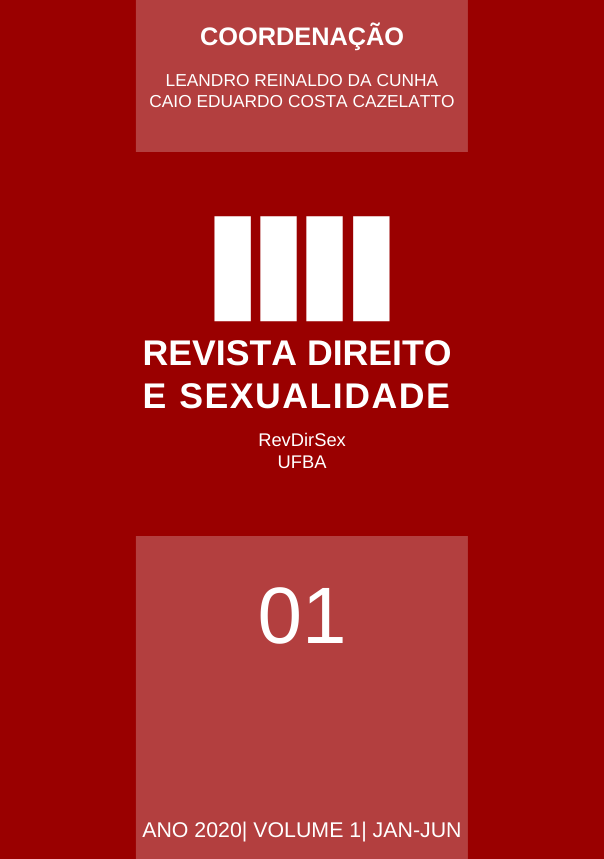A MULHER NEGRA E O CINEMA COMERCIAL: UMA ANÁLISE SOBRE DIREITO, CORPO SOCIAL E ESTEREÓTIPOS.
DOI:
https://doi.org/10.9771/revdirsex.v1i1.36862Abstract
O presente trabalho consiste em uma análise da mulher negra no cinema comercial e como tais arquétipos independem de uma indústria cinematográfica específica, reproduzindo estereótipos do imaginário cultural e coletivo e exibindo séculos de opressão nas telas de cinema sobre o lugar que ocupa este corpo feminino associado a o direito ao corpo e a relação da mulher negra na condição de corpo como objeto.Downloads
References
BRASIL. Lei n.11.340, de 7 de agosto de 2006. Brasília, DF, 7.ago.2006. Disponível em: <http://www.planalto.gov.br/ccivil_03/_ato2004-2006/2006/lei/l11340.htm>.Acesso em: 08/06/18.
Camila Horbatiuk Dutra. CONSUMO, REPRESENTAÇÃO E AGÊNCIA DO FEMININO NO CINEMA COMERCIAL. Disponível em: < http://www.en.wwc2017.eventos.dype.com.br/resources/anais/1499475482_ARQUIVO_Consumo,RepresentacaoeAgenciadoFemininonoCinemaComercial.pdf > . Acesso em : 10/02/2020.
Carneiro, Sueli. Mulheres em movimento. Estudos Avançados. vol.17 no.49 São Paulo : Sept./Dec, 2003. Disponível em :<http://www.scielo.br/scielo.php?script=sci_arttext&pid=S0103-40142003000300008>. Acesso em: 01/12/2017.
Dossiê A situação dos direitos humanos das mulheres negras no Brasil Violências e Violações, 2017. Disponível em: http://fopir.org.br/wp-content/uploads/2017/01/Dossie-Mulheres-Negras-.pdf >. Acesso em: 10/05/2020.
EBC Agência Brasil, Ancine diz que nenhuma mulher negra produziu ou dirigiu filmes nacionais em 2016: Disponível em:<http://agenciabrasil.ebc.com.br/cultura/noticia/2018-01/ancine-diz-que-nenhuma-mulher-negra-produziu-ou-dirigiu-filmes-nacionais-em>. Acesso em: 26/02/2018.
Geledés. 4 Estereótipos Racistas que Hollywood Precisa Parar de Usar, 2016.
Disponível em:https://www.geledes.org.br/4-estereotipos-racistas-que-hollywood-precisa-parar-de-usar/rias-da-tela-mostra-estudo/. Acesso em: 10/09/2017.
GILROY, Paul. O Atlântico Negro: modernidade e dupla consciência. Rio de Janeiro: Ed.34/ Universidade Cândido Mendes, Centro de Estudos Afro- Asiáticos, 2001.
Isabela Alves, Observatório do Terceiro Setor. A solidão tem cor: O sofrimento das mulheres negras no Brasil. Disponível em: < https://observatorio3setor.org.br/carrossel/a-solidao-tem-cor-o-sofrimento-das-mulheres-negras-no-brasil/> Acesso em: 10/05/2020.
JUSBRASIL. Lei 12015/09 | Lei nº 12.015, de 7 de agosto de 2009. Disponível em:< https://presrepublica.jusbrasil.com.br/legislacao/818585/lei-12015-09> . Acesso em: 10/05/2020.
Lélia Gonzalez e outras mulheres: Pensamento feminista negro, antirracismo e antissexismo. In Revista da ABPN, vol. 1, n0 1, março – junho de 2010, pp. 52-63.
LIMA, Mariani. A exclusão da mulher negra nos filmes de grande bilheteria do cinema brasileiro: um olhar sobre a estrutura social na narrativa. Disponível em: <http://mulheresnegrasavbr.com/img/docs/A_exclusao_da_mulher_negra_nos_filmes_de.pdf> Acesso em: 01/12/2017.
LINHARES, Kleiton. O CORPO DA MULHER NEGRA: A DUALIDADE ENTRE O PRAZER E O TRABALHO. Disponível em: < http://www.sies.uem.br/trabalhos/2015/623.pdf> Acesso em: 10/02/2020
Pressão por representatividade em Hollywood não foi bem sucedida, conclui estudo. Revista Cult, 2017, Disponível em:https://revistacult.uol.com.br/home/hollywood-ainda-exclui-mino. Acesso em:10/09/2017.
RIBEIRO, Djamila. O que é lugar de fala?. Belo Horizonte: Letramento, 2017.
Sernegra VII semana de reflexões sobre negritude, gênero e raça: descolonizar o feminismo / Paula Balduino de Melo [ et al.], organizadora – Brasília: Instituto Federal de Educação, Ciência e Tecnologia de Brasília, 2019.
SILVA, Conceição. Mulheres negras e (in)visibilidade: imaginários sobre a intersecção de raça e gênero no cinema brasileiro (1999-2009) . Brasília: 2016. Disponível em:. Acesso em: 01/12/2017.
SANTOS, Júlio; BERARDO, Rosa. Representações Cinematográficas de Mulheres Negras. Goiânia: UFG, FAV, 2014. Disponível em: <https://seminarioculturavisual.fav.ufg.br/up/778/o/2014-eixo1_22_representacoes_cinematograficas_de_mulheres_negras.pdf> Acesso em: 01/12/2017.
Downloads
Published
How to Cite
Issue
Section
License
Copyright (c) 2020 ambos

This work is licensed under a Creative Commons Attribution 4.0 International License.
- This Journal reserves the right to direct normative, spelling and grammatical alterations in original works, with the intention of maintaining the standard worship of the language, respecting the authors' style.
- The exclusive opinions by the authors are their sole responsibility.
- The licensing rights used by the journal are the Creative Commons Attribution 4.0 International License.
- Copyright belongs exclusively to the authors. Sharing (copying and distributing the material in any medium or format) and adaptation (remixing, transforming and re-adapting the original work for all purposes, including commercial) are permitted, provided that due credit is given for the initial publication in this journal.
- Authors are permitted and encouraged to publish and distribute their work online after publication, as this can increase the impact and citation of the published work (See The Effect of Open Access).













